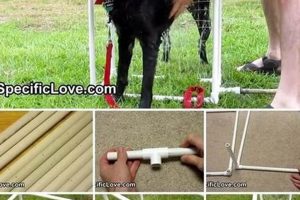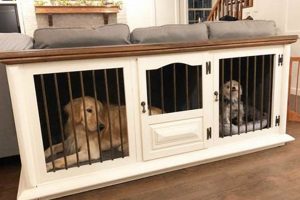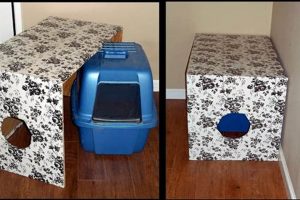Creating personalized resting places for canine companions through do-it-yourself methods constitutes a burgeoning trend in pet care. These custom-made structures, often fashioned from repurposed materials or readily available supplies, offer an alternative to commercially produced pet beds. For instance, an old sweater can be transformed into a cozy, enclosed sleep space for a small dog.
Constructing these bespoke canine accommodations provides several advantages. It offers a cost-effective solution for pet owners, particularly when utilizing recycled materials. This approach also allows for customization to suit a dog’s specific size, breed, and comfort preferences. Historically, homemade pet beds were common due to limited access to specialized pet products, a practice that continues to appeal to those seeking personalized and sustainable options.
The subsequent sections will explore various design ideas, material choices, and construction techniques involved in building comfortable and durable resting places for dogs. Emphasis will be placed on safety considerations and tailoring designs to meet the individual needs of different canine breeds and temperaments.
Tips for Constructing Custom Canine Resting Places
Effective creation of these resting places requires attention to detail and consideration of the animal’s well-being. The following guidelines outline essential factors for successful design and construction.
Tip 1: Material Selection: Prioritize durable, non-toxic materials. Consider fabrics resistant to tearing and chewing. Stuffing should be hypoallergenic and easily washable. For instance, opting for organic cotton or recycled polyester fiberfill reduces allergen exposure and promotes environmental sustainability.
Tip 2: Size and Shape: Accurately measure the dog’s dimensions when resting to determine the appropriate size. Consider the animal’s sleeping style; some prefer to stretch out, while others prefer to curl up. Shape the resting place accordingly. A circular shape can promote a sense of security for some dogs.
Tip 3: Structural Integrity: Ensure the construction is robust and capable of withstanding the dog’s weight and movement. Reinforce seams with multiple stitching passes and select sturdy fasteners. Failure to do so can result in premature deterioration and potential safety hazards.
Tip 4: Washability and Maintenance: Design the resting place to be easily disassembled for cleaning. Removable covers are advantageous for regular washing. Consider using water-resistant or waterproof linings to protect the inner components from spills and accidents.
Tip 5: Safety Considerations: Eliminate potential choking hazards, such as small buttons or loose embellishments. Avoid using materials with sharp edges or abrasive surfaces. Ensure the resting place is stable and unlikely to tip over during use.
Tip 6: Comfort and Support: Incorporate adequate padding to provide joint support and pressure relief. Memory foam or orthopedic foam can be beneficial for older dogs or those with arthritis. Consider adding a raised edge or bolster for dogs who prefer head support.
Adherence to these recommendations contributes to the creation of safe, comfortable, and durable resting places that cater to the specific needs of canine companions, enhancing their well-being.
The following sections will explore advanced techniques and design variations for creating specialized canine accommodations.
1. Material Durability
Material durability is a primary determinant of the lifespan and overall value of a self-constructed canine resting place. The selection of robust materials directly impacts the structure’s ability to withstand the stresses of daily use, including chewing, scratching, and general wear. Inadequate material selection can result in premature degradation, leading to the need for frequent repairs or replacements. For example, utilizing a thin, loosely woven fabric for the bed’s outer layer will likely result in rapid tearing and unraveling, particularly if the dog is prone to digging or nesting behaviors. Conversely, opting for a tightly woven, heavy-duty material such as canvas or upholstery-grade fabric significantly enhances the bed’s resistance to damage, extending its usability.
The practical significance of understanding material durability extends beyond mere cost savings. A durable structure minimizes the risk of ingested fabric fragments, mitigating potential health hazards associated with the consumption of synthetic materials. Furthermore, the use of durable, washable materials contributes to improved hygiene, reducing the accumulation of allergens and bacteria. Consider the example of a bed constructed with a water-resistant canvas exterior and a washable, hypoallergenic filling. This combination provides a barrier against moisture and allergens, simplifying the cleaning process and maintaining a sanitary environment for the dog. Employing durable, reinforced stitching techniques complements material selection, further ensuring the structural integrity of the bed over time.
In summary, material durability is not merely a cosmetic concern but a fundamental requirement for a successful self-constructed canine bed. Careful consideration of material properties, combined with appropriate construction techniques, ensures a safe, comfortable, and long-lasting resting place for canine companions. Addressing this aspect early in the design process mitigates potential hazards and contributes to the overall value and sustainability of the project.
2. Size Appropriateness
Size appropriateness constitutes a critical factor in the successful creation of canine resting places through do-it-yourself methods. The dimensions of the finished structure must correspond accurately to the physical size of the animal. A resting place that is too small restricts movement, causing discomfort and potentially exacerbating joint pain in older animals. Conversely, an excessively large resting place may fail to provide a sense of security, leading to anxiety and reduced utilization. The cause-and-effect relationship between size and canine comfort is well-documented in veterinary behavioral studies. For instance, a Great Dane confined to a bed designed for a Beagle will experience significant physical discomfort, whereas a Chihuahua placed in an oversized bed might feel vulnerable and exposed. Accurate measurements and careful consideration of breed-specific size variations are therefore essential.
The practical application of size appropriateness extends beyond mere comfort. A properly sized resting place promotes better sleep posture, which is crucial for spinal health. It also influences thermoregulation. In colder climates, a snug resting place allows the animal to conserve body heat more effectively. In warmer climates, a larger resting place provides better air circulation, preventing overheating. Consider the example of constructing a bolster bed for a Dachshund. The height of the bolster must be proportional to the dog’s short legs, allowing for easy access and exit. The length and width must accommodate the dog’s elongated body without restricting movement or forcing an unnatural sleeping position. Ignoring these size-related considerations can negate the benefits of the DIY approach.
In summary, size appropriateness is an indispensable component of successful do-it-yourself canine resting place construction. Its impact extends beyond simple convenience to encompass physical comfort, behavioral well-being, and long-term health. Overlooking this aspect can undermine the purpose of creating a custom resting place. Ensuring accurate measurements and tailoring designs to individual canine needs are paramount. The challenge lies in accurately assessing those needs and translating them into functional and comfortable resting spaces.
3. Washability
Washability represents a fundamental consideration in the design and construction of do-it-yourself canine resting places. The ease with which a resting place can be cleaned directly influences its hygiene, longevity, and overall suitability for the animal. Failure to address washability can lead to the accumulation of allergens, bacteria, and parasites, potentially impacting the dog’s health and the cleanliness of the surrounding environment. The following points elaborate on key facets of washability in the context of custom-made canine beds.
- Material Selection and Washability
The choice of materials directly dictates the ease and effectiveness of cleaning. Fabrics that are machine-washable and dryer-safe are preferable. Synthetic materials like fleece or durable cotton blends often retain their shape and integrity through multiple wash cycles. Conversely, delicate fabrics like silk or wool may require specialized cleaning or be unsuitable for use in a dog bed. Water-resistant or waterproof linings are additionally beneficial, protecting the inner fill from moisture and preventing the growth of mold and mildew.
- Removable Covers and Components
Designing a resting place with removable covers significantly simplifies the cleaning process. Covers can be easily detached and laundered separately, preventing the need to wash the entire bed. Zippers or hook-and-loop fasteners provide secure closure while allowing for quick removal. Similarly, the inner fill of the bed should be contained within a separate, removable insert, enabling periodic cleaning or replacement of the stuffing material.
- Cleaning Frequency and Maintenance
Regular cleaning is essential for maintaining a hygienic resting environment. The frequency of washing depends on several factors, including the dog’s shedding habits, activity level, and access to the outdoors. As a general guideline, covers should be washed at least once a month, or more frequently if visibly soiled. The inner fill should be aired out regularly to prevent moisture buildup. Promptly addressing spills or accidents minimizes staining and odor retention.
- Detergent Selection and Allergen Control
The choice of detergent can impact the dog’s health and comfort. Harsh chemicals and strong fragrances can irritate sensitive skin. Opting for hypoallergenic, fragrance-free detergents minimizes the risk of allergic reactions. Thoroughly rinsing the bed after washing is crucial to remove detergent residue. Similarly, hot water washing (when appropriate for the fabric) helps to eliminate dust mites and other allergens.
The integration of these washability-focused considerations is not merely a matter of convenience, but rather a key element in ensuring the health, comfort, and longevity of a self-constructed canine resting place. Ignoring washability can lead to increased maintenance costs, potential health risks for the animal, and a shortened lifespan of the bed itself. Therefore, thoughtful design and material selection focused on ease of cleaning are paramount.
4. Structural Integrity
Structural integrity, as it pertains to do-it-yourself canine resting places, dictates the longevity, safety, and functionality of the finished product. It reflects the ability of the structure to withstand the forces exerted upon it during normal use, encompassing factors such as the dog’s weight, movement, and propensity for chewing or digging.
- Frame Reinforcement
The underlying framework, if present, must possess sufficient strength to support the intended weight load. For elevated resting places, reinforced corners and secure joinery are critical. An example of inadequate frame integrity is the use of thin, unbraced lumber, which may buckle or collapse under the dog’s weight. In contrast, employing thicker lumber, metal supports, and robust fastening methods ensures stability and prevents premature failure.
- Seam Strength and Fastening Techniques
Fabricated resting places rely heavily on the strength of seams and fasteners. Weak seams, resulting from insufficient stitching or the use of inappropriate thread, are prone to tearing under stress. Similarly, poorly secured zippers or closures can detach, compromising the bed’s structure. Employing durable thread, reinforced stitching techniques, and high-quality fasteners mitigates these risks. The utilization of double-stitched seams and heavy-duty zippers represents a best practice for maximizing seam strength.
- Material Resistance to Wear and Tear
The inherent resistance of the chosen materials to wear, abrasion, and tearing directly impacts structural integrity. Fabrics susceptible to rapid degradation, such as thin cotton or loosely woven synthetics, will deteriorate quickly, leading to seam failure and loss of shape. Selecting durable materials, such as canvas, upholstery-grade fabrics, or treated leather, enhances the resting place’s ability to withstand prolonged use and potential abuse. Resistance to moisture is also a factor, preventing the growth of mold and mildew that can weaken the structure over time.
- Cushioning and Support Stability
The stability of the cushioning and support system is integral to overall structural integrity. Padding that shifts excessively or compresses unevenly can compromise the bed’s shape and support capabilities. The use of high-density foam, strategically placed batting, or compartmentalized filling prevents displacement and maintains consistent support. Enclosing the fill within a separate, reinforced inner casing further stabilizes the cushioning and protects against leaks or spills.
The facets of structural integrity highlighted above collectively contribute to the creation of robust and enduring canine resting places. A failure to adequately address these considerations can result in a compromised product, posing potential safety hazards and diminishing the long-term value of the do-it-yourself endeavor. Prioritizing structural integrity ensures that the resulting canine accommodation is not only comfortable but also capable of withstanding the rigors of daily use for the duration of its intended lifespan.
5. Safety
Safety constitutes a paramount consideration in the construction of do-it-yourself canine resting places. Improper design or material selection can introduce hazards that pose risks to the animal’s health and well-being. The consequences of neglecting safety protocols range from minor discomfort to severe injury or even fatality. For example, the use of toxic materials, such as chemically treated wood or lead-based paint, can result in poisoning if ingested or inhaled. Similarly, small, detachable parts, such as buttons or decorative elements, present a choking hazard, particularly for puppies or dogs prone to chewing. A bed with an unstable structure can collapse, potentially trapping or injuring the animal. Therefore, a thorough understanding of potential safety risks and the implementation of preventative measures are essential components of responsible do-it-yourself canine bed construction.
Practical application of safety principles involves careful material selection, secure construction techniques, and the elimination of potential hazards. Non-toxic, pet-safe materials should be prioritized. Fabrics should be durable and resistant to tearing, with seams securely stitched to prevent unraveling. Fasteners, such as zippers or hook-and-loop closures, must be robust and properly installed to prevent detachment. The internal cushioning should be made from hypoallergenic, non-toxic fill materials, such as shredded memory foam or polyester fiberfill. Sharp edges or protruding hardware should be eliminated to prevent cuts or abrasions. A real-world example includes a bed constructed from repurposed wood pallets. If not properly sanded and sealed, these pallets can contain splinters, nails, or chemical residues that pose a threat to the animal. Similarly, a bed with a loosely fitted cover can create entrapment hazards, especially for small dogs or puppies who may become entangled in the fabric.
In conclusion, safety is not a mere afterthought but an integral aspect of responsible do-it-yourself canine bed construction. Its importance stems from the inherent vulnerability of animals and the potential for unintended harm arising from poorly designed or constructed resting places. Addressing potential hazards requires careful planning, informed material selection, and meticulous execution. The challenge lies in anticipating potential risks and implementing preventative measures to create a safe, comfortable, and enriching environment for canine companions. Prioritizing safety is paramount to fulfilling the ethical obligations of pet ownership.
6. Comfort
The pursuit of comfort represents a primary motivation behind the construction of do-it-yourself canine resting places. The link between a dog’s well-being and the quality of its resting environment is direct and significant. An uncomfortable bed can lead to restlessness, sleep disturbances, and, over time, exacerbate existing musculoskeletal issues or contribute to the development of new ones. For instance, an aging dog with arthritis requires a surface that provides adequate cushioning and support to alleviate pressure on sensitive joints. A bed lacking these features will not only fail to provide relief but may actively contribute to increased pain and discomfort. The construction of customized resting places, therefore, allows for the specific tailoring of comfort elements to meet the unique needs of individual dogs.
The practical application of comfort-focused design involves several key considerations. Material selection is paramount; the type of fabric used should be soft, breathable, and non-irritating to the skin. Fill materials, such as memory foam or orthopedic foam, offer superior support and pressure relief compared to traditional stuffing. The incorporation of features such as raised edges or bolsters can provide a sense of security and head support, further enhancing comfort. Consider the example of a small dog prone to anxiety; a bed with high, supportive sides can create a den-like environment, promoting feelings of safety and relaxation. In contrast, a large, open bed may leave the dog feeling vulnerable and exposed, negating any potential comfort benefits. The bed’s design should accommodate the dog’s preferred sleeping position, whether it prefers to stretch out, curl up, or lean against a supportive surface.
Achieving optimal comfort in do-it-yourself canine resting places presents several challenges. Accurately assessing the dog’s individual needs requires careful observation and consideration of factors such as age, breed, health conditions, and behavioral tendencies. Balancing comfort with durability and safety is also crucial; a bed that is overly soft or lacks adequate support may be prone to wear and tear or pose a safety hazard. However, the benefits of prioritizing comfort in canine bed construction are substantial, leading to improved sleep quality, reduced stress levels, and enhanced overall well-being. The investment in time and effort to create a comfortable resting place is an investment in the dog’s long-term health and happiness.
7. Cost-Effectiveness
Cost-effectiveness is a significant motivator for engaging in the construction of do-it-yourself canine resting places. The economic disparity between commercially available pet beds and those crafted from repurposed or inexpensive materials can be substantial. This price differential stems from several factors, including manufacturing overhead, retail markups, and branding costs inherent in commercial products. Conversely, creating a resting place allows for the utilization of resources already available within the household or the acquisition of materials at a reduced cost, thereby minimizing overall expenditure. For instance, repurposing old blankets, pillows, or clothing as filling material effectively eliminates the need to purchase expensive synthetic stuffing. This approach yields significant cost savings, particularly for pet owners with multiple animals or those who require frequent bed replacements.
The application of cost-effective strategies extends beyond mere material selection. Skillful design and construction techniques can further optimize resource utilization and minimize waste. Simple, straightforward designs that require minimal cutting or sewing can reduce material requirements and labor time. The incorporation of reclaimed lumber or recycled plastic for the bed’s frame, when appropriate, presents a sustainable and economical alternative to purchasing new construction materials. An example of cost-effective design is a simple pillow-style bed constructed from two pieces of durable fabric sewn together and stuffed with recycled pillow filling. This design requires minimal skill and materials, making it accessible to a wide range of individuals, regardless of their prior crafting experience. Such beds can be customized in size and fabric choice to match the dog’s specific needs and the owner’s aesthetic preferences.
In conclusion, cost-effectiveness represents a central advantage of do-it-yourself canine resting place construction. The ability to repurpose materials, minimize waste, and circumvent commercial pricing structures results in significant economic benefits for pet owners. While challenges may arise in balancing cost savings with factors such as durability and safety, the potential for achieving substantial savings makes the do-it-yourself approach an attractive option for budget-conscious individuals seeking to provide comfortable and personalized accommodations for their canine companions. Careful planning and resourcefulness are key to maximizing the cost-effectiveness of these projects.
Frequently Asked Questions
The following section addresses common inquiries concerning the construction and utilization of canine resting places created through do-it-yourself methods. These questions aim to provide clarity on key aspects of design, materials, safety, and maintenance.
Question 1: What materials are most suitable for constructing long-lasting and safe resting places for canines?
Durable, non-toxic materials are paramount. Heavy-duty fabrics like canvas or upholstery-grade materials withstand wear and tear. Hypoallergenic fillings, such as shredded memory foam or polyester fiberfill, minimize allergic reactions. Chemically treated woods or fabrics containing harmful dyes are to be avoided.
Question 2: How can one ensure a custom-built canine bed provides adequate orthopedic support?
Orthopedic support is achieved through the strategic use of high-density foam or memory foam. The thickness and density of the foam should correspond to the animal’s weight and size. Elevated sides or bolsters can offer additional support for the head and neck.
Question 3: What cleaning protocols are recommended for homemade canine resting places to maintain hygiene?
Removable, machine-washable covers are essential for regular cleaning. Fabrics should be washed in warm water with a mild, hypoallergenic detergent. The inner fill should be aired out periodically to prevent moisture accumulation and the proliferation of bacteria. Stains should be addressed promptly to prevent permanent damage.
Question 4: How does one accurately determine the correct dimensions for a canine resting place?
Accurate measurements are critical. The dog’s dimensions should be measured while it is lying in its preferred sleeping position. Additional space should be allocated to allow for stretching and movement. Consider the animals breed-specific size characteristics.
Question 5: What safety precautions should be implemented when constructing a canine bed to prevent potential hazards?
All potential choking hazards, such as small buttons or decorative embellishments, should be eliminated. Sharp edges or protruding fasteners must be avoided. The bed’s structure should be stable and unlikely to tip over. Non-toxic materials should be used exclusively.
Question 6: What are the advantages of opting for a do-it-yourself canine bed versus a commercially manufactured option?
The primary advantages include customization, cost-effectiveness, and the ability to utilize repurposed materials. Customization allows for the creation of a bed tailored to the animal’s specific needs and preferences. Cost-effectiveness can be realized through the use of inexpensive or recycled materials. Repurposing materials promotes sustainability and reduces waste.
The information presented here underscores the importance of careful planning and execution in the creation of canine resting places. The health and well-being of the animal are paramount.
The subsequent section will explore advanced design concepts and innovative material choices for constructing specialized canine accommodations.
DIY Dog Beds
This exploration has illuminated the multifaceted nature of creating canine resting places through do-it-yourself endeavors. Key points encompass material durability, size appropriateness, washability, structural integrity, safety, comfort, and cost-effectiveness. Each element contributes directly to the overall value and suitability of the finished product, impacting the animal’s well-being and the bed’s longevity.
Given the demonstrated potential for customization, cost savings, and sustainable practices, the conscientious application of these principles is warranted. The commitment to thoughtful design and meticulous construction ultimately translates to enhanced comfort and safety for canine companions. The pursuit of these custom accommodations requires a dedication to detail, informed decision-making, and a recognition of the significant impact these creations have on the lives of domestic animals.







